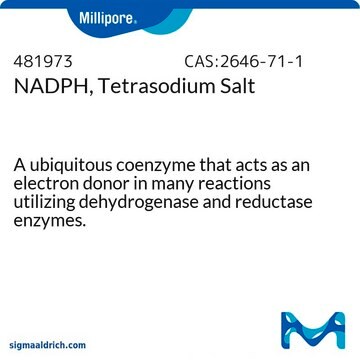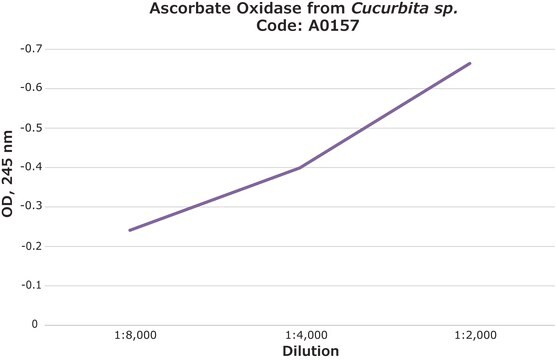G3664
Glutathione Reductase from baker′s yeast (S. cerevisiae)
ammonium sulfate suspension, 100-300 units/mg protein (biuret)
Synonim(y):
GR, NAD(P)H:oxidized-glutathione oxidoreductase
About This Item
Polecane produkty
Postać
ammonium sulfate suspension
aktywność właściwa
100-300 units/mg protein (biuret)
masa cząsteczkowa
118 kDa
numer dostępu UniProt
obecność zanieczyszczeń
G-6-PDH, 6-PGDH, and NADPH oxidase ≤0.01%
lipoamide dehydrogenase ≤0.1%
temp. przechowywania
2-8°C
informacje o genach
bakers yeast ... GLR1(856014)
Szukasz podobnych produktów? Odwiedź Przewodnik dotyczący porównywania produktów
Opis ogólny
Zastosowanie
- in the glutathione assay to determine glutathione concentration.
- as a standard in the generation of calibration curve.
- as an antigen to measure plasma activity of GR.
- for quantifying the myocardial tissue glutathione content using a glutathione reductase-5,5′-dithiobis (2-nitrobenzoic acid)-based enzymatic recycling assay
- for the quantification of reduced glutathione (GSH) in the oocytes, using a slightly modified microglutathione assay, obtained from prepubertal gilts
- for the preparation of total GSSG (glutathione disulphide) + GSH measurement, where all available GSSG was reduced to GSH, in rat lens
- for the quantification of intracellular reduced glutathione (GSH) in the oocytes obtained from rats
Działania biochem./fizjol.
Definicja jednostki
Postać fizyczna
Uwaga dotycząca przygotowania
inhibitor
produkt powiązany
Hasło ostrzegawcze
Danger
Zwroty wskazujące rodzaj zagrożenia
Zwroty wskazujące środki ostrożności
Klasyfikacja zagrożeń
Resp. Sens. 1
Kod klasy składowania
12 - Non Combustible Liquids
Klasa zagrożenia wodnego (WGK)
WGK 2
Temperatura zapłonu (°F)
Not applicable
Temperatura zapłonu (°C)
Not applicable
Certyfikaty analizy (CoA)
Poszukaj Certyfikaty analizy (CoA), wpisując numer partii/serii produktów. Numery serii i partii można znaleźć na etykiecie produktu po słowach „seria” lub „partia”.
Masz już ten produkt?
Dokumenty związane z niedawno zakupionymi produktami zostały zamieszczone w Bibliotece dokumentów.
Klienci oglądali również te produkty
Produkty
Instructions for working with enzymes supplied as ammonium sulfate suspensions
Nasz zespół naukowców ma doświadczenie we wszystkich obszarach badań, w tym w naukach przyrodniczych, materiałoznawstwie, syntezie chemicznej, chromatografii, analityce i wielu innych dziedzinach.
Skontaktuj się z zespołem ds. pomocy technicznej









